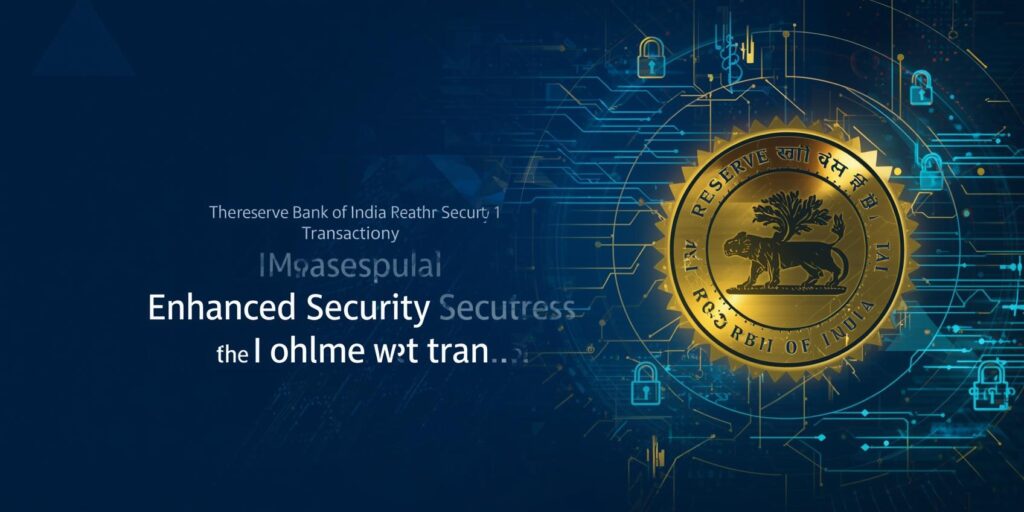
RBI Tightens Security for Online Transactions: What You Need to Know
Digital payments in India have grown by leaps and bounds in recent years.
Whether we are paying via UPI, credit/debit cards, mobile wallets, or net banking, most of our everyday transactions happen online.
This convenience is wonderful — but it also brings greater risk of fraud, hacking, and misuse.
To guard against these risks, the Reserve Bank of India (RBI) has introduced fresh and more stringent guidelines for authentication of digital payments.
In this blog post, I’ll walk you through:
- What the new RBI rules are
- Why they matter (for you, the consumer)
- The challenges and criticisms
- How banks and payment service providers are likely to implement them
- What YOU can do to stay safe
- What to watch out for in the future
Let’s begin.
1. What are the new RBI authentication guidelines?

a) Two-Factor Authentication becomes mandatory
Under the new rules, all digital payment transactions in India must use two factors of authentication (2FA) from April 1, 2026.
What does this mean?
It means that simply entering a password or PIN (a “single factor”) is not enough.
A second factor is needed — such as an OTP, biometric scan, device verification, token, etc.
One of the two factors must be dynamic — unique and tied to that particular transaction.
So, for example: your bank or payment app might ask you to enter an OTP (one factor) and also confirm via fingerprint (the second factor).
Or you might use a device token alongside a password.
The idea is to combine something you know + something you have or something you are.
Importantly: the RBI is not banning SMS-based OTPs. They remain a valid authentication factor. But new options are also being allowed.
25 Best Credit Cards in India (2025) – Rewards, Cashback & Benefits
b) Risk-based checks / additional authentication
The new guidelines also allow risk-based checks.
That means banks and payment providers can assess a transaction for its risk level (based on pattern, location, device, amount, etc.).
And then decide whether extra authentication is necessary.
So for a low-risk transaction (say, a small amount, from a familiar device), the system might accept the basic 2FA.
But for a high-risk transaction (unusual amount, new device, cross-border, etc.), extra checks might be invoked (for instance, biometric verification or more steps).
c) Special rules for cross-border / card-not-present transactions
One of the vulnerable areas is card-not-present (CNP) transactions, especially cross-border ones (when a merchant overseas request payment).
Under the new rules, from October 1, 2026, Indian card issuers must validate additional authentication for non-recurring, cross-border, card-not-present transactions (if the merchant or acquirer requests it).
Also, card issuers will be required to register their Bank Identification Numbers (BINs) with card networks to improve oversight.
d) Exceptions & special cases
The guidelines do carve out some exceptions. For example:
- Card-present transactions (when you physically swipe or insert your card) may not need the same level of dynamic authentication.
- Recurring payments (like subscriptions or e-mandates) may have special handling.
- Some low-risk or offline transactions may have lighter rules. (The idea is not to make small everyday payments tedious.)
e) Liability and compensation responsibility
An important clause: if a bank or payment service provider fails to comply with these authentication rules, and a customer suffers a loss because of it, the issuer may have to compensate the customer.
That makes the rules not just guidelines but obligations, with real financial accountability.
2. Why these new rules matter (for you and me)

a) Fraud & misuse are rising
As digital payments scale, fraudsters are more active — via SIM swap attacks, unauthorized access, phishing, cloned apps, etc.
Transactions where the card or device is not physically present offer more loopholes. The new rules aim to plug those holes.
From the regulator’s side, introducing stricter authentication is meant to balance convenience with stronger security.
b) More trust in digital payments
When users feel their money is safer, they are more confident to use digital payments more often (for shopping, services, remittances, subscriptions).
That supports financial inclusion and the digital economy.
c) Encourages innovation in authentication technology
The guidelines explicitly allow newer methods — biometric checks, device tokens, passphrases, behavioral checks, etc. — so the payments industry can evolve beyond just OTPs.
This opens room for more seamless and user-friendly security (for instance, face recognition, fingerprint, or invisible checks) rather than always forcing the user to type OTPs.
d) Stronger protection in cross-border payments
When Indians shop from international merchants or use global services, there is risk because their cards are used remotely (card-not-present).
The new rules put more guardrails so that such transactions get extra checks.
e) More accountability from banks / issuers
Because banks must comply and may face consequences (compensation obligations) for non-compliance.
They are more incentivized to build robust systems and prevent security lapses.
Top 35 Best Educational YouTube Channels to Learn Anything
3. Challenges, risks, and criticisms
No rule is perfect, and implementing these new guidelines comes with trade-offs and concerns. Let’s explore them.
a) User inconvenience vs friction
One major worry is that stronger authentication might make payments slower or more cumbersome, especially for less tech-savvy users.
Requiring more steps or biometric scans for every transaction could frustrate users if not done smartly.
If every small payment becomes a “hassle,” some people might resist or avoid digital payments.
b) Infrastructure readiness & cost
Banks, fintechs, payment processors, and merchants will need to upgrade systems, integrate biometrics, device tokens, risk engines, etc.
That requires investment, time, and technical capacity.
Smaller players, especially regional banks or local payment service providers, may struggle to keep pace.
c) Privacy, data security concerns
Using biometrics (fingerprint, face scan), device data, or behavior for authentication means more personal data is collected and processed.
That raises risks of data leaks, misuse, or unauthorized access.
It must be handled with strict data security norms.
Ensuring compliance with privacy laws (like India’s Digital Personal Data Protection Act, 2023) is going to be crucial.
d) False positives and friction on legitimate users
Sometimes even legit users might trigger “high risk” rules (say they travel temporarily, switch phone, etc.).
If too many extra checks are forced, true users may get blocked or delayed in performing legitimate transactions.
e) Transition, backward compatibility
Existing systems, apps, merchants, and users will have to adapt.
There will be a transition period during which interoperability issues or confusion may arise.
f) Exemptions misuse
Exemptions (e.g. for recurring payments) have to be managed carefully so that fraudsters don’t exploit those loopholes.
Scapia Federal Credit Card Review: Free Domestic Lounge Access, Zero Forex Markup & No Annual Fees
4. How banks, fintechs, and payment services will likely implement these rules
Now that we understand what the rules require and the challenges, here’s how the ecosystem is likely to respond and adapt.
a) Multi-factor / alternative authentication methods
Instead of relying only on OTPs, banks will roll out or integrate:
- Biometric methods (fingerprint, face recognition)
- Device tokens (software/hardware)
- Passphrases or “something you know”
- Behavioral authentication (monitoring usage patterns, device fingerprints)
- Contextual checks (location, time, device, IP)
Because one factor must be dynamic per transaction, many banks will generate transaction-specific tokens or codes, rather than static passwords.
b) Risk scoring engines and fraud analytics
Banks will use risk scoring models that assign “risk weights” to every transaction.
Based on the risk score, additional authentication steps may be triggered.
Low-risk transactions may go through quickly with minimal friction.
High-risk ones may need multiple checks.
Such risk engines will use features like:
- Device used and its history
- Geographical location / IP
- Transaction amount
- Past behavior of the user
- Time of transaction
- Whether this is a new merchant or pattern
c) Phased rollout & testing
Given the complexity, many issuers will adopt a phased rollout: starting with high-volume transactions, or pilot segments, then gradually covering all cases.
They may also give users options (e.g. allow fallback to OTP-based authentication) for a transition period.
d) Merchant / acquirer integration
Merchants, especially online ones, will need to integrate with the stronger authentication flows.
Payment gateways will also need to support the new protocols, so that transaction flows remain seamless.
In cross-border CNP payments, overseas merchants may request extra authentication, so systems must interoperate internationally.
e) Customer education & support
Banks will invest in educating customers — popups in apps, SMS/email alerts, tutorials — explaining the new checks.
Why they’re necessary, and guiding users through biometric setup, device registration, etc.
Support teams will also need to handle more queries, complaints, or fallback if authentication fails.
f) Compliance and audits
Banks and payment providers will need internal audit and compliance mechanisms to ensure they meet RBI’s directions, maintain logs, undergo security audits, and be ready to compensate customers if rules are breached.
5. What YOU can do to stay safe and be prepared

As a user, these new rules are ultimately for your benefit — but you can also take proactive steps to stay safe, smooth the transition, and protect your funds.
a) Keep your devices secure
- Update your phone’s operating system, apps, and security patches regularly.
- Avoid rooting or jailbreaking your device if possible.
- Use strong PINs, passcodes, or biometric locks for unlocking.
- Don’t install apps from untrusted sources.
b) Be careful with SMS / OTPs / phishing
- Never share OTPs, PINs, or verification codes with anyone, even if they claim to be from your bank.
- Be suspicious if someone calls, messages, or emails you asking for codes. Legit banks never ask for them.
- Avoid clicking on unknown links in SMS or email (phishing).
c) Register biometric / device authentication early
When your bank or payment app offers you the option to register your fingerprint, face scan, or device token, do so early.
This will make future transactions easier under the new rules.
d) Monitor transaction notifications & alerts
Use SMS, email, or in-app alerts to monitor transactions.
If you see a payment you didn’t make or a high-risk approval message you didn’t expect, act quickly (block card, contact bank).
e) Use strong passwords, varied across apps
Don’t use the same password for everything.
Use a password manager or strong, unique passwords for banking, payments, apps, and email accounts.
f) Use trusted apps and official app stores
Install banking and payment apps only from official stores (Google Play Store, Apple App Store). Keep them updated. Avoid using modded apps or cloned ones.
g) Be patient and learn the new flows
During the transition, some transactions may feel slower or have extra steps.
Don’t panic.
Recognize that the extra security is for your safety.
h) Report fraud early
If you suspect fraud or unauthorized access, immediately contact your bank, freeze the affected card or account, file a complaint, and escalate as needed.
6. Examples / scenarios to illustrate
Let me show a few example scenarios to make this real.
Scenario 1: A routine small payment
You pay ₹100 on an online store using your card. Under the new rules:
- The system detects this as a relatively low-risk transaction (familiar device, location, small amount).
- Your bank asks for a password and an OTP (or biometric verification) — two factors.
- Transaction approved and completed.
For you, it’s not much change — just an extra step you’re already accustomed to.
Scenario 2: A bigger payment or unusual merchant
You buy ₹50,000 worth of goods from a new online merchant you’ve never used before.
- The risk engine flags this as risky due to the large amount and unfamiliar merchant.
- The bank may ask for extra verification — say biometric login, device verification, or an additional dynamic token.
- Only then the transaction is approved.
Scenario 3: Cross-border card-not-present transaction
You order something from an overseas website using your Indian credit card.
- Because this is a cross-border, card-not-present transaction, the merchant could request extra authentication under the new rules.
- The bank will validate the extra factor (biometric, token, etc.) for this one-time transaction (if required).
- Only if authentication is successful, the payment is accepted.
Scenario 4: Travel, using a new device
Suppose you travel to another city (or abroad) and try to make a payment from a different phone or SIM.
- The bank’s system may see that as an unusual device or location, flag it as higher risk, and ask you for additional verification steps (for instance biometric plus device registration).
- If you haven’t pre-registered your device or biometric login, there may be friction — but usually banks allow fallback verification or manual override after checks.
These examples show how dynamic and context-aware the new guidelines are, striking a balance between security and usability.
7. What to watch out for in coming months & future trends
The RBI’s guidelines take effect from April 1, 2026. But the months leading up to that, and the time after, will be critical. Here’s what to watch:
a) Phased rollout and pilot testing
Banks and fintechs will slowly roll out new authentication methods and test them in controlled segments. Pay attention to which apps or banks introduce biometric flows early.
b) User experience — smoother flows
The real success will depend on how seamless the experience is.
If users are forced through too many steps, adoption could suffer.
The smarter systems will use “invisible” authentication (behavioral, device-level) to minimize user friction.
c) Standards, interoperability
All these systems (banks, apps, gateways) need to talk to each other.
Standard protocols (e.g. APIs for biometric, token, device identity) will emerge.
Interoperability across banks and cross-border systems will be critical.
d) Legal and privacy guardrails
As biometric and device data gets collected more widely, privacy laws must keep pace.
How the data is stored, encrypted, handled, and consented will be a key concern.
India’s data protection laws will likely play a big role.
e) Fraudsters adapt too
With stronger authentication, fraudsters will look for newer loopholes: social engineering, device compromise, malware, zero-day attacks, etc.
Security practices must evolve continuously.
f) international adoption and harmonization
Indian banks and payment providers may adopt global best practices, and Indian rules may increasingly align with global frameworks (EMV, PCI DSS, ISO standards).
This would help cross-border transactions and foreign merchant acceptance.
g) Consumer adaptation & literacy
Over time, consumers will become comfortable with biometric payments, passphrases, tokenization, etc.
Education campaigns, simpler user interfaces, and trustworthy communication will help.
8. Summary on RBI Tightens Security for Online Transactions: What this means for you (key takeaways)
- From April 1, 2026, all digital payments in India must use two-factor authentication, with one factor being dynamic.
- OTPs remain valid, but newer methods (biometric, device tokens, behavioral checks) are encouraged.
- For cross-border card-not-present transactions, extra authentication will be required in many cases.
- Banks, fintechs, merchants will need to upgrade systems, integrate new authentication flows, and educate users.
- As a user, get ready — enable biometric/device-based authentication, keep your device secure, monitor your transactions, and beware of phishing.
- During transition, some extra steps or friction are normal — be patient.
- Privacy, data protection, and user experience will be critical in how smooth and acceptable the new system is.
Frequently Asked Questions
What are new RBI guidelines for online transactions?
The RBI has mandated that from April 1, 2026, all digital payments in India must use two-factor authentication (2FA), with at least one factor being dynamic (like an OTP, biometric, or device token) for every transaction. The guidelines also allow risk-based checks and require extra authentication for cross-border card-not-present payments, while holding banks accountable for compliance and customer protection.
Which method is secure for online transactions?
The most secure methods for online transactions are those that use two-factor authentication (2FA), combining something you know (like a PIN or password) with something you have or are (like an OTP, biometric, or device token). Among these, biometric authentication and device-based tokens are considered safer than SMS OTPs, since they are harder to intercept or misuse.
What is the RBI circular on cyber security for banks?
The RBI circular on cyber security for banks lays down a comprehensive framework that requires banks to implement strong cyber risk management, continuous monitoring, incident reporting, and robust defense mechanisms against threats. It mandates setting up a board-approved cyber security policy, real-time detection systems, regular audits, and timely reporting of breaches to the RBI to safeguard customer data and financial stability.





























